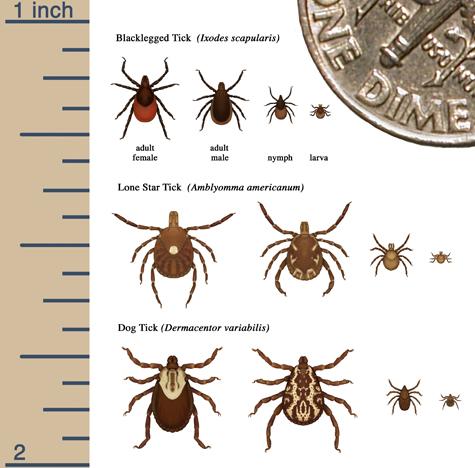Ticks and Schools
On this page:
Basics

Photo Credit: CDC
Ticks are found throughout the world, but thrive in warm and humid regions and in areas with hosts (wild and domestic animals, and humans). They carry the most diseases of any arthropod and can spread disease from region to region as they are transported by hosts.
Ticks have two main body sections:
- a head; and
- a body.
Adults have eight legs that protrude from the body.
Ticks begin to appear in the spring as eggs develop into larva. The late spring and summer are the highest risk seasons for tick bites.
Life Cycle
- Ticks begin as eggs, which transition into larvae.
- The next two phases require blood meals:
- nymphs
- adults
- Generally, ticks feed three times before they mate, reproduce, and die.
Tick Management Checklist
- Deer ticks are most active from April through October, so be extra cautious when venturing into tick country.
- In a tick-infested area, use an insect repellent. Consider using a product designed to be applied to clothing rather than your skin.
- Tuck pants cuffs into boots or socks, and wear long sleeves and light-colored clothing so it is easier to spot ticks.
- Stay to the center of hiking paths, and avoid grassy and marshy woodland areas.
- Inspect yourself and your children for clinging ticks after leaving an infested area:
- Deer ticks are hard to see:
- nymphs are dot-sized;
- adults, smaller than a sesame seed.
- Deer ticks are hard to see:
- If you discover a tick feeding, do not panic: studies indicate that an infected tick does not usually transmit the Lyme organism during the first 24 hours.
- If you suspect Lyme disease or its symptoms, contact your doctor immediately.
Fact Sheets and Other Resources on Ticks
- Tick Safety in Schools - Integrated Pest Management for Protecting Children from Tick-Borne Diseases - An EPA document that includes detailed information about tick management around schools.
- Springtime Means Tick Time: Learn to Protect Yourself - A blog post that includes links to other tick resources.
- Stop Ticks - Tick bite prevention for pets and for children and adults playing or working in their backyard, from CDC.
- Tick-borne Diseases of the U.S. - This CDC Web page reviews 12 diseases transmitted by ticks and provides links to additional information.
- IPM Management Manual: Ticks - This National Park Service web page reviews the different types of ticks, lifecycles, and non-chemical control options.
- Ticks Fact Sheet from the National Park Service Office of Public Health
- Tick Bite Prevention (PDF) (8 pp, 520 K, About PDF) - A scholarly article written by Dr. Kirby C. Stafford III and published by the Connecticut Agricultural Experiment Station.
- School IPM Fact Sheet (PDF) (4 pp, 171 K) on Ticks from the Maine Department of Agriculture
- IPM Action Plan for Ticks Exit- This Web page provides information regarding the identification, removal, prevention and monitoring of ticks, as well as links to other resources.
- Read more about integrated pest management.
